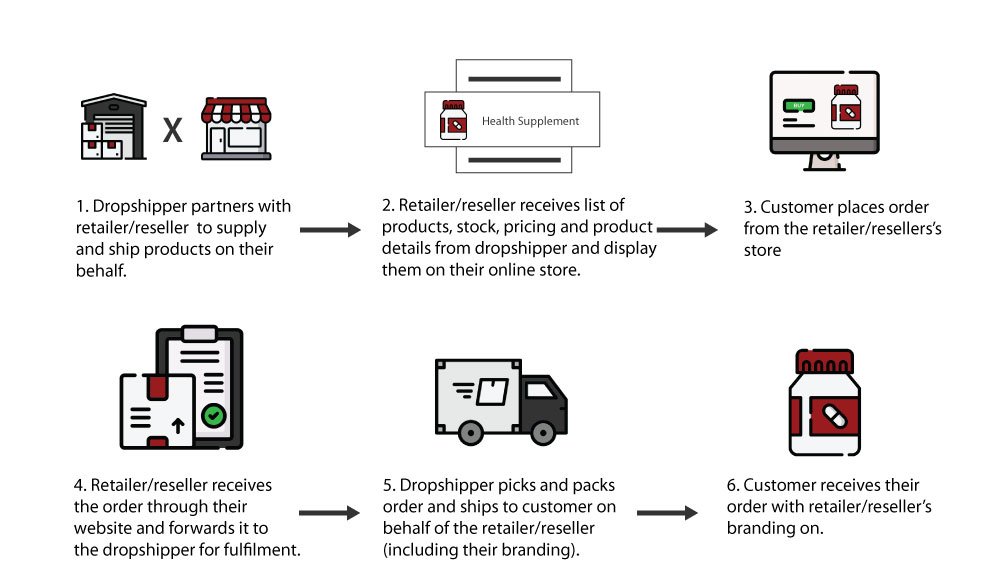
Dropshipping for growth: A smart strategy for both manufacturers & retailers
Channel conflict is an ongoing battle for manufacturers, wholesalers and distributors so they are often loath to open a direct-to-consumer channel and potentially damage relationships, or lose business, from their retailers/resellers who they are looking to support.
However, like any business, they are always looking for new ways to increase their revenue. One mutually beneficial idea, continuing to grow in popularity, is offering dropshipping on behalf of those retailers and resellers.
What is dropshipping?
So, what do we mean by dropshipping? Dropshipping is a fulfilment method where an online store sells products without physically keeping them in stock. Instead, when a customer places an order, the retailer/reseller purchases the item from a third-party supplier—such as a manufacturer or wholesaler—who then ships it directly to the customer. This allows retailers/resellers to offer a wide range of products without managing inventory, reducing upfront costs and logistical complexities.
A typical dropshipping set up looks like this

Why tradeit/Red?
Manufacturers and wholesalers looking to expand their reach and support their retail partners/resellers need an advanced ecommerce platform like tradeit to efficiently facilitate dropshipping. Not every dropshipping requirement is the same so flexibility is key and tradeit can be configured to support different dropshipping models. Managing a dropshipping operation at scale requires seamless integration between product data, stock management, order processing, and retailer/reseller storefronts, ensuring that products are accurately listed, stock levels are updated, and orders are fulfilled directly to customers without delays.
tradeit provides automated workflows, real-time data synchronisation, and flexible order routing, allowing manufacturers and wholesalers to streamline operations, eliminate manual inefficiencies, and offer a superior dropshipping service. This not only enhances their relationships with retailers/resellers by providing a hassle-free fulfilment solution but also opens new revenue streams, enabling them to scale their business without the complexities of direct-to-consumer selling.
Benefits for the dropshipper
So, let's examine the benefits for the dropshipper.
1. Increased sales & revenue
They gain access to a broader customer base without investing in direct marketing or selling directly to the consumer themselves. More retailers and resellers selling their products means higher order volumes.
2. No need for direct customer acquisition
Their resellers handle customer acquisition and sales, reducing the need for extensive marketing efforts. This saves on advertising costs but still enables them to reach new customers.
3. Reduced inventory risk
They no longer rely solely on in-house sales channels—products move through multiple resellers so there is a steadier order flow helping to manage stock levels more efficiently.
4. Streamlined operations
As the focus is on fulfilment and logistics rather than retail operations, there is less of a requirement to manage customer enquiries, returns, or front-end sales.
5. Lower overhead costs
There is no requirement to run a retail ecommerce store or invest in front-end retail infrastructure. This helps avoid any costs related to maintaining physical storefronts or customer service teams.
6. Scalable Business Model
They can easily scale fulfilment operations by working with multiple resellers. This provides them with the flexibility to expand into new markets without direct investment in B2C sales.
7. Increased Loyalty
By providing a dropshipping service to their customers, those who adopt it are more likely to remain loyal to them as a supplier due to the extra value they are providing.
How it works
The flexibility of tradeit means that it can be set up to work in a number of ways, depending on the dropshipper's requirements, but there are two distinct options:
Basic
The basic option is designed to be simple to set up and uses tradeit's inherent Call Centre functionality, making it ideal for smaller retailers or resellers looking for a straightforward way to expand their product offering. The process begins with the retailer or reseller registering for a dropshipping account—this can be completed online if required. Once the application is reviewed and approved by the dropshipper, a dedicated dropshipping account is created for the retailer/reseller.
Following approval, the account is configured to suit the specific parameters of the dropshipping arrangement. Certain site features or options may be modified or disabled, depending on the agreement. For example, this can include adjustments to:
- Delivery and shipping rules
- Available product range (e.g. only a selected subset of items may be available for dropshipping)
- Currency settings (if the service is restricted to specific regions)
- My Account settings
- Product offers and promotions
- Triggered email communications (i.e. abandoned basket campaigns)
- Loyalty schemes
These customisations ensure that the retailer’s experience is aligned with the dropshipper’s operational model while providing a smooth and focused ecommerce experience for the end customer.
Once the account is set up, the retailer or reseller receives a stock feed from the dropshipper (this could come directly from their ERP system or PIM). This feed contains up-to-date product, pricing, and inventory information, enabling them to list the available items on their own website or present them directly to customers. To support a seamless end-customer experience, the retailer is also asked to provide their company logo, which is applied to packing slips and shipping documentation. This ensures that all orders appear to be dispatched directly from the retailer, maintaining brand consistency.
When a customer places an order with the retailer or reseller, the same order can then be submitted through their dropshipping account on the dropshipper's website. While this process involves manual entry, it provides a straightforward and accessible starting point for small businesses looking to adopt a dropshipping model without the need for complex integrations.
Automated
The advanced dropshipping option follows the same initial setup process as the basic model, including account registration, approval, and configuration, and the provision of a stock feed. However, the key difference lies in the automation of the ordering process through an API integration.
Once the dropshipping account is approved, retailers gain access to the API documentation directly within their online account. This enables them to automate the fulfilment workflow by routing customer orders from their own website directly to the dropshipper for processing.
Orders submitted via the API are automatically flagged, and a scheduled task within the tradeit platform retrieves and processes them. During this process, several automated checks can be performed to ensure:
- The delivery address is valid and delivery option is available to that location
- The products exist, are live, and available for dropshipping
- Any quantity restrictions are respected
- Payment can be successfully processed
- There is sufficient account balance
If required, a final manual check for order approval can also be applied, then if all criteria are met, the order is seamlessly processed, and the dropshipper dispatches the goods directly to the end customer—complete with retailer-branded packing slips. This advanced integration is ideal for more established retailers/resllers seeking a scalable, hands-off fulfilment solution that reduces manual input and streamlines operations.
Both dropshipping options allow retailers and resellers to offer the dropshipper’s product range without holding any stock themselves, significantly reducing overhead and risk. In addition, they can benefit from any promotions or special offers the dropshipper is running, enabling them to stay competitive and drive sales without the need for upfront investment.
